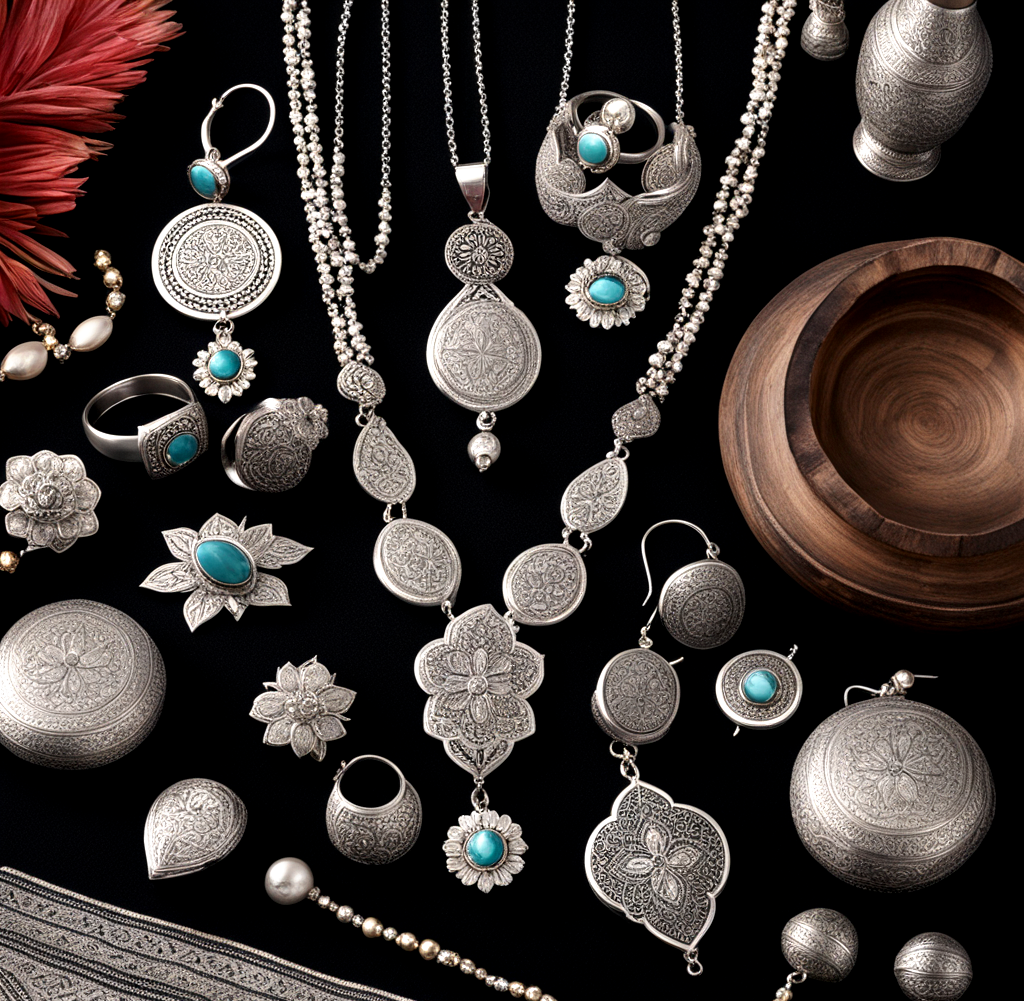
Moroccan silver jewelry is a fascinating combination of history, creativity, and cultural importance. Moroccan silver jewelry, known for its elaborate patterns and skilled craftsmanship, has become a symbol of beauty and legacy. This article dives into the numerous kinds and designs of Moroccan silver jewelry, the handcrafted skills required in its production, and the cultural backdrop that makes it unique.
A Brief History Of Moroccan Silver Jewelry
The history of Moroccan silver jewelry is intricately linked to the country’s unique cultural tapestry. Silver has been used in Morocco for ages and is commonly linked with luxury and dignity.
The Berber tribes of the region have a long history of making silver jewelry, which they use not just as ornament but also as cash and protection against evil spirits.
Traditionally, ladies wore silver jewelry, particularly during weddings and celebrations. Each item frequently has symbolic implications, expressing the wearer’s identity, social standing, and even marital status.
Moroccan silver jewelry has changed over time, drawing inspiration from a variety of civilizations, including Arab, Berber, and Andalusian designs.
The Craftsmanship of Moroccan Silver Jewelry
One of the most striking features of Moroccan silver jewelry is the artistry involved in its fabrication. Artisans, often known as “jewelry makers” or “silversmiths,” use ancient skills passed down through generations. Moroccan silver jewelry making is a labor-intensive procedure that needs a high level of skill and attention to detail.
Moroccan silver jewelry: Material Used
The major material used in Moroccan silver jewelry is silver, frequently in the form of 925 sterling silver, which is made up of 92.5% pure silver and 7.5% additional metals, most often copper. This alloy is popular because of its durability and resistance to tarnishing. In addition to silver, artists may use semi-precious stones, glass beads, and enamel to improve the beauty of their works.
Techniques and Tools
Moroccan silversmiths use a range of techniques to make their jewelry. Some of the most frequent ways are:
Hammering: This method shapes the silver by striking it with a hammer, resulting in beautiful patterns and textures.
Chasing and Repoussé: These techniques involve pressing or striking metal from behind to create raised patterns on the front.
Filigree is a delicate technique that requires twisting and soldering small silver wires to form exquisite lace-like shapes.
Granulation: This technique involves fusing microscopic silver balls to the surface of the jewelry to produce artistic patterns.
Artisans frequently use rudimentary hand tools, depending on their talent and ingenuity to create exquisite creations.

Styles & Designs for Moroccan Silver Jewelry
Moroccan silver jewelry comes in a variety of styles and patterns that represent the region’s distinct cultural influences and creative traditions. Here are a few of the most common styles:
Berber Jewelry
Berber jewelry is distinguished by its striking patterns and symbolic themes. Berber works, which frequently feature geometric forms, spirals, and nature-inspired features, hold cultural importance.
Common symbols include Fatima’s hand, which is said to provide protection, and the crescent moon, which represents femininity and fertility. Berber jewelry is often huge and statement-making, with massive rings, ornate necklaces, and enormous earrings.
Amazigh Jewelry
The Amazigh people, often known as Berbers, wear a specific kind of jewelry that represents their nomadic lifestyle. Intricate carvings and vivid stones are common aspects of Amazigh jewelry. Necklaces may have big pendants, whilst bracelets are often broad and richly adorned. The use of brilliant colors and strong motifs distinguishes Amazigh jewelry.
Moroccan Tribal Jewelry
Tribal jewelry combines numerous cultural influences, frequently including pieces from different areas of Morocco. This style is distinguished by its eclectic use of materials like as silver, beads, and gemstones. Tribal items are frequently intricately made and meant to be worn in layers for a striking and dramatic effect.
Contemporary Moroccan Jewelry
In recent years, contemporary Moroccan jewelry has grown in popularity, combining traditional methods with modern aesthetics. Designers are experimenting with new forms, materials, and styles, resulting in creations that appeal to a worldwide audience. Contemporary Moroccan jewelry frequently incorporates simple designs, clean lines, and a focus on craftsmanship, while also recognizing ancient practices.
Cultural Significance of Moroccan Silver Jewelry
Moroccan silver jewelry is more than simply a fashion statement; it has profound cultural importance. Each item conveys a tale about the history, beliefs, and values of the community that created it. Here are some important features of the cultural significance of Moroccan silver jewellery:
Moroccan silver jewelry: Symbol of Identity
Jewelry is an essential part of Moroccan culture, serving as a symbol of identity and belonging. Different regions and tribes have their unique styles and motifs, allowing individuals to express their heritage and cultural pride. Wearing traditional jewelry can signify one’s connection to their roots and community.
Rites of Passage
In Moroccan culture, jewelry plays a vital role in significant life events. For example, during weddings, brides often wear elaborate silver jewelry as part of their traditional attire. These pieces are not only beautiful but also carry blessings and protection for the bride as she embarks on her new journey.
Spiritual beliefs
Many Moroccan silver jewelry items carry mystical implications. Symbols like the hand of Fatima and the eye of Horus are said to protect against the evil eye and bring good fortune. Wearing these ornaments is believed to bring spiritual direction and protection to the person.
Economic Importance
Many Moroccan craftsmen rely on the craft of silver jewelry creation as their primary source of livelihood. By conserving ancient processes and making beautiful works, these craftsmen help to preserve their communities and the local economy. Supporting Moroccan silver jewelry protects cultural heritage while also empowering local artists.
Care for Moroccan Silver Jewelry
Proper care is crucial to ensuring that your Moroccan silver jewelry looks attractive and lasts for many years. Here are some suggestions for keeping your pieces:
Regular Cleaning
Silver jewelry may tarnish over time when exposed to air and moisture. To clean your Moroccan silver jewelry, use a soft cloth to carefully remove any dirt or oils. To remove more tenacious tarnish, use a silver polishing cloth or a mild silver cleanser. Avoid using powerful chemicals that might ruin the exquisite decorations.
Storage
When not in use, keep your silver jewelry in a cool and dry area. Consider using a soft bag or a fabric-lined jewelry box to avoid scratches and tangling. Keeping your jewelry out of direct sunshine and humidity can help keep it shiny.
Avoiding Damage
Avoid wearing your Moroccan silver jewelry while swimming, jogging, or indulging in activities that might cause it to become damaged or twisted. Also, remove your jewelry before using lotions, perfumes, or hair treatments, since they might cause discolouration.

Where To Buy Moroccan Silver Jewelry
Moroccan silver jewelry is renowned for its intricate designs, cultural significance, and craftsmanship. If you’re looking to add some unique pieces to your collection or find the perfect gift, here’s a guide on where to buy authentic Moroccan silver jewelry.
Local Markets and Souks
One of the best places to find Moroccan silver jewelry is in the bustling markets, known as souks, throughout Morocco. Cities like Marrakech, Fes, and Essaouira are famous for their vibrant souks filled with artisans selling handmade jewelry. Here, you can find a variety of pieces, from traditional Berber designs to contemporary styles.
Tips for Shopping:
– Bargaining: Don’t hesitate to negotiate prices; it’s a common practice in Moroccan markets.
– Authenticity: Look for hallmarks or ask the seller about the materials used to ensure you’re buying genuine silver.
Online Retailers
If you can’t travel to Morocco, many online retailers specialize in Moroccan silver jewelry. Websites like Etsy, Amazon, and dedicated jewelry sites often feature artisans who sell their work online. This option allows you to browse a wide selection from the comfort of your home.
https://www.babouche-maroc.com/en/beauty-and-fashion-moroccan-silver-berber-jewels-c-55_31.html
Recommended Online Stores:
– Etsy: A platform for handmade and vintage items, where you can find unique pieces directly from Moroccan artisans.
– Amazon: Offers a variety of Moroccan silver jewelry, but be sure to check reviews and seller ratings for authenticity.
Specialty Boutiques
In many cities around the world, you can find specialty boutiques that focus on Moroccan or North African goods. These shops often curate a selection of authentic Moroccan silver jewelry, ensuring quality and craftsmanship.
How to Find Them:
– Search online for local shops that specialize in international or Moroccan goods.
– Check out cultural festivals or markets in your area, as they often feature vendors selling Moroccan jewelry.
Artisan Fairs and Craft Shows
Keep an eye out for artisan fairs and craft shows in your area. These events often feature local artisans, including those who specialize in Moroccan crafts. Purchasing directly from artisans not only supports their work but also gives you the opportunity to learn more about the pieces and their cultural significance.
Social Media and Influencers
Social media platforms like Instagram and Facebook have become popular for artisans to showcase and sell their work. Many Moroccan jewelers use these platforms to reach a global audience. You can follow hashtags like #MoroccanJewelry or #MoroccanSilver to discover new artisans and their collections.
Engagement Tips:
– Don’t hesitate to reach out to sellers for more information about their pieces.
– Look for customer reviews or testimonials to gauge the quality of the jewelry.
Read more about moroccan handicrafts https://handes.net/the-beauty-of-a-moroccan-rug-wonderful-creativity/


